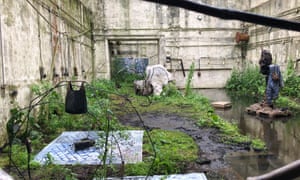Orford Ness: the apocalyptic art zone at war with nature
UFO sightings, a Nazi invasion, nerve gas trials, unexploded bombs … the strange Suffolk enclave of Orford Ness has always inspired artists, and now it hosts the most unsettling project yet

It is one of Britain’s strangest landscapes, a spit of land off the Suffolk coast littered with the rusting junk of a mysterious and sinister past. Over the decades, musicians, film-makers, artists and writers have been sucked into its ghostly orbit, captivated by what the great existential wanderer WG Sebald imagined as “the remains of our own civilisation after its extinction in some future catastrophe”.
It’s now a nature reserve, but for much of the 20th century, Orford Ness was forbidden territory, sealed off for military purposes from the village whose picture-book church and castle can be seen from its desolate shingle beach. In 2014, Anya Gallaccio captured the decades of anxiety surrounding Ness with a series of hugely magnified photographs of a pebble believed to have been fractured by first world war bomb experiments. Jamiroquai used its strange colonnaded pagodas – designed in the 1950s to collapse in on themselves if a nuclear experiment went wrong – for the dystopian video of Automaton.
Three of the latest crop of artists to be drawn there – in a collaboration between Artangel and the National Trust, which bought the site from the Ministry of Defence in 1993 – have filled its spooky derelict buildings with installations: Alice Channer has created a triffid-like plant thrusting bladed tentacles through the window frames of an abandoned shelter; Tatiana Trouvé has imagined the leavings of some survivalist community mouldering away in the puddles of a roofless laboratory; and Emma McNally has run an undulating silver sea of paper through the old armoury.
The problem with any visual response is that it is hard to match the disorientating bleakness of Orford Ness itself, part of which is to do with the myths that surround it. In his psycho-geographic travelogue The Rings of Saturn, Sebald wrote of a “horrifying incident” in the nearby village of Shingle Street in 1942, possibly involving an unreported Nazi invasion or a military drill that went fatally wrong. Why else would the Ministry of Defence have extended the embargo from 30 to 75 years on a file mysteriously titled Evacuation of the Civil Population from Shingle Street, Suffolk? When the files were eventually opened in 1992, after lobbying from local press, there turned out to be nothing top secret contained in them – but it did little to dampen rumours of death rays, nerve gases and petroleum infernos.
But there is another story to Orford Ness that this new exhibition – called Afterness and lasting well into autumn – addresses, one that speaks even more powerfully to our own times. Over the centuries, this stretch of coast has been in a war of attrition with nature. In 1627, a single storm wrecked 32 ships, which were ground to fragments by the shifting shingle. Eleven lighthouses have been built to guide mariners through the deadly darkness, most of them washed away by the sea. The most recent, dating from 1792, was the last functioning building on the Ness until it was decommissioned in 2013. Although it was finally demolished last year, that lighthouse has now become part of the myth, surviving in spectral outline with the dawn breaking over it in Cobra Mist, an evocative film by Emily Richardson that takes an unsettling tour of the site to a soundtrack by Chris Watson. His recordings of Ness, from gulls to surf and shrieking winds, are also part of Afterness, echoing around the top of an old black wireless beacon as part of the Library of Sound.
Months before its demolition, the lighthouse was memorialised in a film and music project by the singer-songwriter Thomas Dolby, as the symbolic centre of a “docutour” of the area he grew up in. Orford Ness “has seeped into my chord changes and lyrics” he says in The Invisible Lighthouse, which begins with a beam of light sweeping round as handwritten words appear on screen. “My ancestors came here thousands of years ago from Europe,” they say as the light sweeps round again. “They walked. There was no North Sea then.”
The phone and drone technology Dolby used was cutting-edge in 2013, but is already becoming as dated as the antique aviator goggles he wore. “It was a precious project,” he says. “I have a childhood memory of watching the flash from Orford Ness on my bedroom wall as I fell asleep at night. But in later years, the light seemed too dim for that to have been true. It led me to an investigation of false memories and the power of auto-suggestion.” In the film, he speculates that the same beam might have been responsible for a UFO sighting by US servicemen in nearby Rendlesham Forest in 1980.
For Dolby, Orford Ness is a reminder that England itself is slowly and inexorably tipping eastwards into the North Sea as the north-west of Britain rises. Robert Macfarlane captures the attritional swoosh and sloosh of this process in his book-length prose poem Ness, which is illustrated by Stanley Donwood with etchings of the very buildings that are now being reanimated by Afterness. “Drift,” writes Macfarlane, “is a world-shaper, which makes itself up as it goes along, acknowledging its debts to the plastics & fishing industries, and to the global capital flows that determine prevailing trade cutters … Drift is unimaginably vast and if you had to describe Drift you would need a new kind of map and a new kind of language. The only end to Drift would be the end of the oceans, which in turn would be the end of the planet.”
It is into this stream of melancholy that the Ukrainian-American poet Ilya Kaminsky taps, in the small masterpiece that will stand as the legacy of Afterness, long after the artworks have been disassembled and the buildings left to the birds and the hares. I See a Silence is a cycle of 42 poems, some just a few lines long, that accompany you through headphones as you traipse the six-mile path around the Ness, between signs warning about the unexploded ordnance all about you. “Ness exhausts,” writes Kaminsky, “with skylarks, boat motors, gulls, gravel, with the embarrassed silence of an empty stairwell in the ballistics building, with goosesteps, knowing that silence of the living is visible at Ness, in your lungs and in mine, in a single bee’s drone.”
Kaminsky has never been to Orford Ness, nor has he ever heard the drone of a single bee because – as the opening poem makes clear – he is deaf. Prevented from visiting by the pandemic, he says: “In the end I was lucky not to go. I was given this strange chance not to go and be a documentarian. I had to ask instead: what are the metaphysics of the place? And what is the wonder/play of that? What is real about it to someone who has never visited? Because it is still my planet, so it’s gotta be real. Just scratch the surface and see the planet.”
In The Rings of Saturn, Sebald is terrified by the sudden, unexpected appearance of a hare, while Kaminsky is wearied by the “metaphysical bumfluff” of rabbits. Crunching along the empty beach, with his poems ringing in my ears, I begin to wonder if there are any hares left today; why they would come to this place of salt and stones; whether they might have blown themselves up by wandering off the path. Then my foot slips and I look down. Towards where I fancy the lighthouse once stood is a neat pile of “metaphysical bumfluff” in a prickly oasis of greenery. It’s somehow very funny. The ultimate message of this project and this place is that all that will survive of us is sea kale and rabbit poo, feeding off each other, with no need of “us” at all.
Afterness is at Orford Ness, Suffolk, on selected days until 30 October. Tickets via the National Trust.



